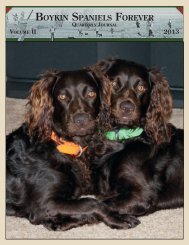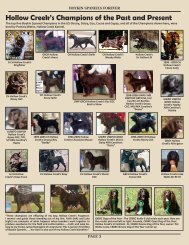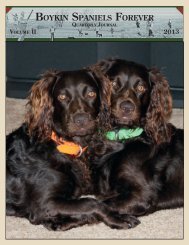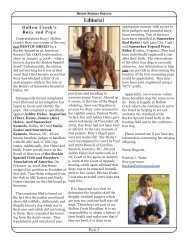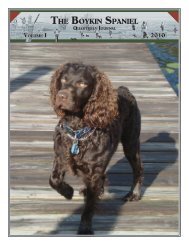Volume IV - Hollow Creek Kennel
Volume IV - Hollow Creek Kennel
Volume IV - Hollow Creek Kennel
- No tags were found...
You also want an ePaper? Increase the reach of your titles
YUMPU automatically turns print PDFs into web optimized ePapers that Google loves.
BOYKIN SPANIELS FOREVERPAGE 6
While in the midst of breeding andpuppy season, it is important to understandthe basics of canine orthopedichealth, specifically hip health when makingbreeding decisions for your own kennel orchoosing a Boykin Spaniel puppy. TheBoykin Spaniel is currently listed as #13 inthe Orthopedic Foundation for Animals(OFA) list for occurrence for hip dysplasia.OFA suggests that 37% of the BoykinSpaniels that they have evaluated have presentedas positive for the presence of thedisease. The incidence of hip dysplasia ishigh considering the weight and size ofthe breed, but not unusual for a rare breedwith a small genetic pool. Historically OFAhas been the leader in providing evaluationservices for canine hip health. Mostrecently the PennHIP procedure hasgained in popularity and as a result manyBoykin owners and breeders are using it asan alternative or adjunct evaluation to traditionalOFA hip evaluations.The PennHIP procedure is an advancedradiographic technique used to quantitativelymeasure and identify hip joint laxityand serve as a predictor and indicator ofdegenerative joint disease (DJD) or caninehip dysplasia (CHD). PennHIP stands forUniversity of Pennsylvania HipImprovement Program. Throughout theUnited States and worldwide there is a networkof veterinarians who have beentrained in this highly specialized method.Results become part of the University ofPennsylvania’s comprehensive researchdatabase. As this database grows, it hasbeen structured to generate increasinglyprecise data aimed at supporting improvementwithin breeding programs and toprovide owners and breeders with datawith which to predict DJD and to identifyCHD.Currently results are sent to an ownerand the veterinarian post the evaluation.PennHIP hopes to have its public databaseonline by the end of the year.Radiographs and identification materialsare never handled by an owner and theentire process is managed by a trainedPennHIP veterinarian to prevent any andall possibility of fraud. Participation in thedatabase is required and once an evaluationhas been completed, the PennHIP veterinarianis required to submit the radiographs,unlike other evaluation methodsthat are subject to an owner’s option.The PennHIP method is different in themanner that it evaluates canine hips vs.other methods such as that recommendedby the Orthopedic Foundation for Animals(OFA). PennHIP involvesthree separate radiographs:the distraction view, thecompression view and thehip-extended view. Thehip-extended view usedhistorically by OFA isemployed as supplementaryinformation regardingBOYKIN SPANIELS FOREVERthe actual presence of DJD. PennHIPuses actual qualitative measures by providingscoring vs. traditional methods thattend to be subjective, ranging formExcellent to Severe, based on a single viewevaluation without any scientific measurement.PennHIP is performed only by veterinarianswho have undergone extensivetraining in the method and have demonstratedtheir expertise in performing theprocedure. A searchable database of veterinariansis available on the PennHIPwebsite (http://www.pennhip.org). Thecosts tend to be higher then those of traditionalOFA evaluations but involve aseries of radiographs. To obtain diagnosticquality radiographs, the musculaturearound the hip joint must be completelyrelaxed. For the comfort and safety of theanimal, this requires either heavy sedationor general anesthesia. The selection of theindividual sedation/anesthesia protocol isleft to the PennHIP veterinarian's discretion,so long as the dog is sufficientlysedated to obtain a diagnostic quality radiograph.Upon request, most PennHIP veterinarianscan make a copy of the hip-extendedradiograph for submission to the OFA atthe time your dog has a PennHIP evaluation.You do not have to abandon participatingin the OFA database or receiving anOFA certificate for your dog. It does nothave to be an “either or” decision.PennHIP evaluations and reports consistof a distraction index (DI) for each hip,expressed in the form of a decimal. DI isa measurement of maximal passive hiplaxity. It is a unitless number between 0and 1. A smaller DI means less laxity(tighter hips) and less susceptibility forDJD. A DI of 0.50 is interpreted to meanthat the femoral head is 50% displacedfrom the acetabulum (hip socket). The DIhas been shown to correlate strongly witha dog's probability of developing hip DJD.The larger the DI, the greater the probabilityfor DJD. PennHIP has identified athreshold DI of 0.30; dogs with a DI of
BOYKIN SPANIELS FOREVERVÉäxÜjtzáAAA9 UÜtzá4Izzie & CooperOwner: Donnie &Catherine Judy ofSC“Cooper” - Leslie Harris ofGreenwich, Ct.Texas Trace Libby’sBody Double in theHouston ChroniclePAGE 8
BOYKIN SPANIELS FOREVERWaggin’ Tails ...9-month old Texas Trace“Addison” (Addie) gearing upfor dove season.“Cara” - After going throughobedience training, hunting andtrying to keep her busy we startedbasic agility at about 20months. This was new to both ofus but she really liked it so wekeep on through intermediateand then advanced. We enteredour first test, second test, etc andwere not doing very good as I was making more mistakes than Carawas. The club sponsored a training course by a woman that has one ofthe top ten agility dogs in the country. It was a great course and wewere about through it and looking forward to the fall tests when shefell off the dog walk and tour her cruciate ligament in her left hind leg.This took us out of the fall tests and hunting until the snow was deep,but we did get in some hunting. We had to train in the snow thisspring after it got low enough that snowshoes were not needed. Wewent to our first test (jumpers as the vet recommended that she not becampaigned in regular agility) and she ended up with a second becauseso many others did not qualify in the cold and damp first outdoor testin the spring in the area. Then in the summer tests, she did take a firstand then another first with a perfect 100 score. We now go the openand she thinks 10 weaves are ok and why do 12? We are entered in theOctober test andwe will see whomakes the mostmistakes.- HaroldStanlick7 mo. old “Gilbert” -Robyn Howland“Deacon” & Little Sister “Dakota”- Justin Brooks of Wilmington, NCPAGE 9
BOYKIN SPANIELS FOREVER...& More Waggin’ Tails!<strong>Hollow</strong> <strong>Creek</strong>'s “Just Sassie”& “Jake” - Craig Parker“Peat”-Ed and ChristianChristoffers“Tucker”- Mary Whitney of NHLast December we purchased a<strong>Hollow</strong> <strong>Creek</strong> pup from yoursatellite breeder in Connecticut.Zoey is a true Boykin joy. Ihave four good friends who areGolden Retriever lovers andZoey has them reconsidering....People comment on the unusualcolor of my Cocker Spaniel.You can place a solid bet that Itake the opportunity to educatethem about our belovedBoykins. I can't imagine howmuch fun it must be to see severalof them interact on a dailybasis. When I retire I hope toget more.- Linda M. Sutton,Oakland, CA“Sullivan” -Chris & CourtneyChalloner, SCPAGE 11
Happy <strong>Hollow</strong>-days!Wishing You a Merry Christmas &a Happy New Year!BoykinSpanielsForever.com<strong>Hollow</strong> <strong>Creek</strong> <strong>Kennel</strong>Patricia L. Watts803-532-0990Got Anything Boykin Spaniel?Want them to be published in the Journal?Email them with a caption or description andyour name and state of residence toBoykinsForever@aol.comBoykin RescueWeb Links:American <strong>Kennel</strong> Club - www.akc.org • United <strong>Kennel</strong> Club - www.ukcdogs.comBoykin Spaniel Rescue - www.boykinrescue.org • OFA - www.offa.org • CERF - http://www.vmdb.org/cerf.htmlBOYKIN SPANIELS FOREVERC/O HOLLOW CREEK KENNEL1018 ASBILL COURTLEESVILLE, SC 29070HTTP://BOYKINSPANIELSFOREVER.COMBOYKINSFOREVER@AOL.COMQUARTERLY JOURNAL



